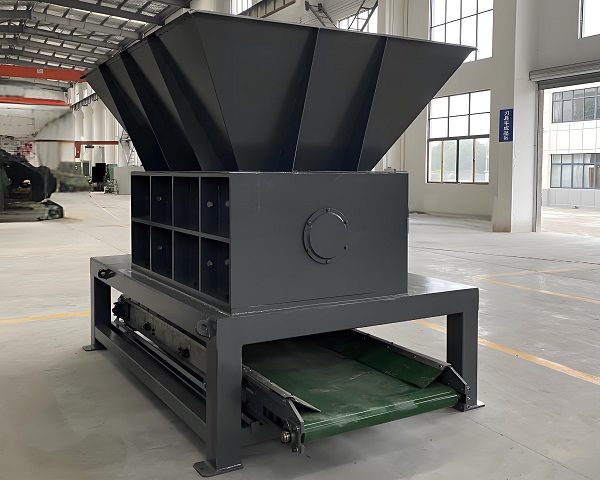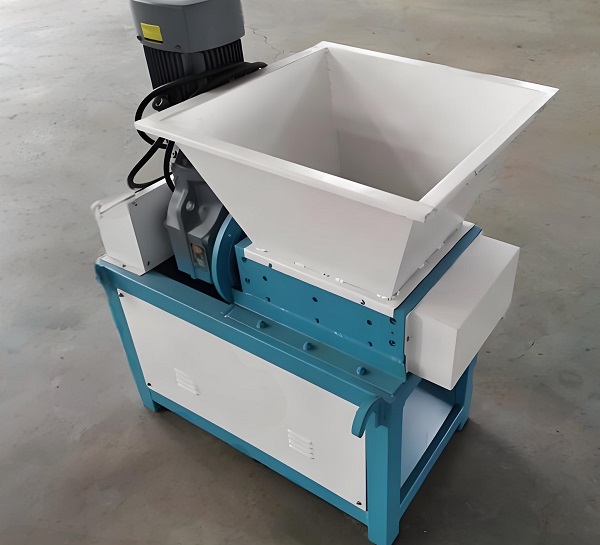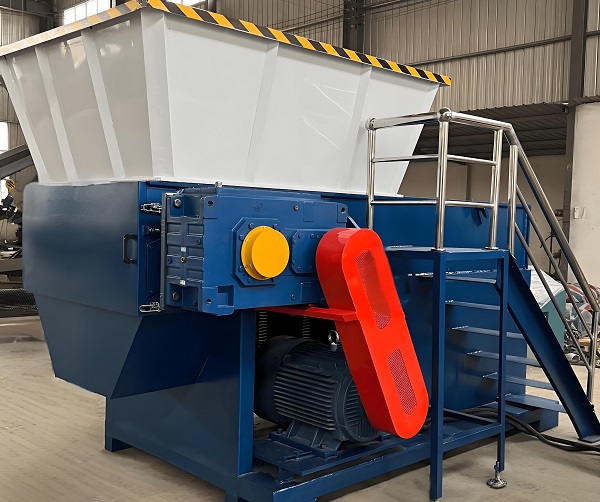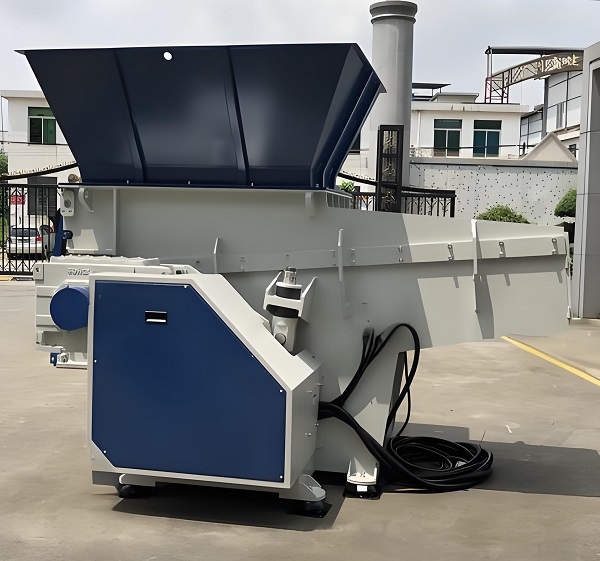In the field of material shredding and resource preprocessing, single-shaft shredders, with their unique structural design, have established a core position in the market segment. Compared to dual-shaft and other multi-shaft models, their streamlined "single blade shaft + fixed blade carriage" construction offers cost, energy, and operational advantages in small and medium-sized applications. From plastic recycling to rural waste disposal, their diverse blade designs and integrated processes adapt to diverse needs. This article focuses on the structural and performance advantages and application-specific features of single-shaft shredders, analyzing their value through case studies and data, while also exploring optimization options to provide a reference for industry selection and technology upgrades.
Core Advantages: Performance Breakthroughs Based on Structural Features

1. Cost and Operational Advantages of Simplified Structure
Single-shaft shredders are renowned for their minimalist "single blade shaft + fixed blade carriage" structure. Compared to dual-shaft models, they eliminate one drive system and blade shaft assembly, reducing manufacturing costs by 30%-40%. With a typical purchase price of 50,000 to 200,000 yuan per unit, they are more suitable for the budgets of small and medium-sized enterprises. Its core moving parts consist solely of the blade shaft and drive motor, reducing failure points by 60% and significantly simplifying maintenance. Data from a plastic recycling plant in Jiangsu Province shows that single-spindle models require an average monthly maintenance time of only 8 hours, 12 hours less than dual-spindle models, saving nearly 30,000 yuan in annual maintenance costs.
The blade shaft is particularly convenient to maintain. Models with a modular cutterhead design allow individual blades to be replaced when worn, without disassembling the entire blade shaft. This reduces replacement time from 4 hours for dual-spindle models to 1 hour. High-end models equipped with an automatic lubrication system extend the blade shaft lubrication cycle to 15 days, further reducing labor costs. Furthermore, the equipment occupies only 60% of the floor space of dual-spindle models with the same processing capacity, making it more adaptable to small waste treatment plants with limited space.
2. Strong material adaptability and controllable shredding performance.

The single-shaft shredder utilizes the shearing action of a high-speed rotating blade shaft (up to 50-150 rpm) and a fixed blade carriage to process a wide range of materials, particularly flexible, fibrous, and medium-hard materials. In plastics recycling, it can shred PE/PP sheets under 20 mm thick into 10-50 mm particles, achieving 90% particle size uniformity. When processing scrap tires, the toothed blade disc separates the tread rubber and steel wire, resulting in a rubber purity exceeding 95%, eliminating the need for additional separation steps.
Precise and controllable shredding performance is another key advantage. By adjusting the blade shaft speed and the distance between the blade discs, the output particle size can be infinitely adjusted. For food waste, adjusting the blade disc distance to 20 mm produces easily sieving small pieces; for waste paper, adjusting it to 50 mm ensures subsequent sorting efficiency while avoiding excessive shredding and dust generation. Tests at a waste paper recycling company showed that this equipment can flexibly adjust shredding parameters based on paper grade, increasing the qualified pulp rate in subsequent screening by 18%.
3. Better Energy and Noise Control
Single-shaft shredders, due to their simplified drive system, have significantly lower specific energy consumption than multi-shaft models. Mainstream models using variable-frequency motors consume only 15-25 kWh per ton of plastic, a 25%-35% reduction compared to dual-shaft models. When processing biomass straw, specific energy consumption is as low as 8 kWh per ton, meeting the energy-saving requirements of agricultural waste treatment. Data from a biomass energy plant in Zhejiang Province showed that after introducing a single-shaft shredder, the proportion of energy consumed in the pre-processing stage decreased from 22% to 14% of the total system, saving over 80,000 kWh of electricity annually.
Noise control is also excellent. By optimizing the blade shaft's dynamic balancing design and employing a soundproof enclosure, the equipment's operating noise level is controlled below 75dB, significantly lower than the 90dB of dual-shaft models. This makes it easier for small waste disposal stations near residential areas to pass environmental inspections. After adopting a single-shaft shredder at a community food waste disposal site, noise complaints dropped from 5 to 0 per month, achieving a balance between environmental protection and public welfare.
Core Features: Deep Adaptation of Technical Features and Application Scenarios

1. Single-Shaft Drive, Concentrated Crushing Force
The core feature of a single-shaft shredder is its reliance on a single blade shaft for crushing power. This shaft is connected to the motor via a gearbox, transmitting concentrated torque to the cutterhead. Mainstream models offer torques ranging from 500 to 5000 N·m, generating powerful shearing force to crush medium-hard materials. This concentrated force provides a significant advantage when processing tough materials. For example, when crushing 15mm thick rubber products, a dual-shaft shredder requires dual-shaft rollers to apply pressure, while a single-shaft shredder achieves direct shearing and crushing with concentrated torque, improving processing efficiency by 20%. However, it's important to note that while this concentrated crushing force requires high material feed uniformity, it's often used in conjunction with a vibrating feeder to prevent blade shaft jamming caused by material accumulation. A metal recycling plant using a "vibrating feeder + single-shaft shredder" combination has reduced the scrap metal shredder jam rate from 12% to 1.5%, extending the equipment's continuous operation time to over 12 hours.
2. Diverse Cutter Head Designs for Precise Application Adaptation
As the core working component, the design of the cutter head directly determines the application for which the equipment is suitable. Single-shaft shredders offer a diverse range of cutter head types:
Toothed cutter heads: With a tooth spacing of 5-15mm, they are suitable for flexible materials such as plastics and rubber, creating a tearing effect during shredding. A tire recycling plant in Jiangsu uses this cutter head, achieving a rubber shredding efficiency of 3 tons/hour.
Flat-blade cutter heads: With sharp cutting edges, they are suitable for fibrous materials such as paper and cloth, preventing fibers from tangling around the cutter shaft. A textile waste processing plant in Shandong has seen a 90% reduction in fiber tangling failures after using this type of cutter head.
Special-shaped cutter heads: With a special raised structure, they are suitable for sticky materials such as food waste, breaking up clumps. A food waste processing plant in Zhejiang has seen a 30% increase in material screening efficiency.
This precise adaptability enables single-shaft shredders to cover over 80% of small and medium-sized material shredding applications, making them specialized equipment for this niche application.
3. Combined Crushing and Screening Functions Simplify Processes
Single-shaft shredders perform both crushing and initial screening. A screen mesh is typically installed beneath the blade shaft. After crushing, materials that meet the required particle size are discharged through the screen, while oversized particles remain in the crushing chamber for further crushing, creating an integrated "crushing-coarse screening" process. This feature reduces investment in subsequent screening equipment and is particularly suitable for small-scale resource recovery projects.
Small construction waste treatment plants use a "single-shaft shredding + fine screening" process. The shredder's built-in 30mm screen first removes large impurities, while the subsequent fine screening only processes materials that meet the required particle size. This improves overall system screening efficiency by 40% and reduces equipment investment by 25%. In the agricultural sector, when processing corn stalks, a single-shaft shredder can directly produce materials that meet biomass power generation requirements through a 10mm screen, eliminating the coarse screening step required in traditional processes and simplifying the process by 30%.
4. High Mobility, Suitable for Decentralized Processing
Small and medium-sized single-shaft shredders generally utilize wheeled or tracked chassis, weighing only 2-5 tons and easily transportable by forklift or small trailer, making them ideal for decentralized waste disposal. In rural waste management, mobile single-shaft shredders can operate on a roving basis, shredding waste from various villages and towns before transferring it to a central processing station. A county in Hebei Province implemented this model, reducing waste transportation costs by 45%. During emergency rescue operations, these shredders can quickly reach disaster sites, shredding construction waste and other debris, and providing support for the development of rescue routes.
Mobile models are typically equipped with diesel generators, eliminating the need for external power sources. They can operate even in remote areas without grid coverage, further broadening their application. Diesel-powered single-shaft shredders are used at mining waste processing sites to enable on-site shredding and recycling of waste, saving 60% in transportation costs.
Existing Limitations and Optimization Directions

Despite their significant advantages, single-shaft shredders still have shortcomings: When processing high-hardness materials (such as steel plates over 20mm thick), the cutter head wears quickly, shortening the replacement cycle to 1-2 months. When processing bulky materials, uneven force can easily cause the cutter shaft to bend, requiring strict control of feed size. To address these issues, the industry is optimizing in three areas:
Material Upgrade: Utilizing tungsten carbide-coated cutter heads extends their lifespan to over 6 months.
Intelligent Improvement: Integrated infrared detection systems automatically identify ultra-hard materials and shut down the machine. Application in metal recycling plants has reduced the rate of cutter shaft bending failures by 95%.
Structural Optimization: Developing models with adjustable cutter shaft speed automatically adjusts the speed based on material hardness. This reduces speed and increases torque when processing high-hardness materials, balancing efficiency and equipment protection.
With advantages such as a streamlined structure, low energy consumption, and precise application adaptability, single-shaft shredders have become a staple in small- and medium-sized material crushing and pre-processing operations. Their core features of "centralized crushing force + multiple cutter heads + integrated process" perfectly meet the needs of decentralized, small-scale resource recovery. Despite limitations in handling high-hardness materials, their application is expanding with material innovation and intelligent upgrades. As the "Zero Waste City" initiative expands to counties, single-shaft shredders, with their cost and adaptability advantages, will play an even more important role in small- and medium-sized waste treatment projects, promoting the refined development of the circular economy.
Save Time! Get A Detailed Quotation Quickly.
